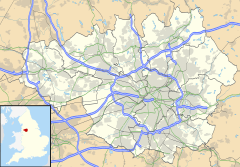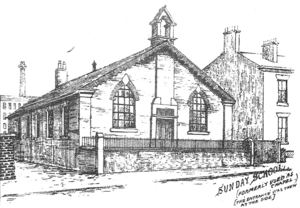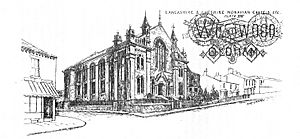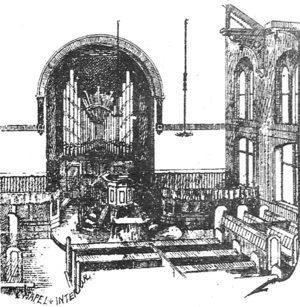Westwood Moravian Church facts for kids
Quick facts for kids Westwood Moravian Church |
|
|---|---|
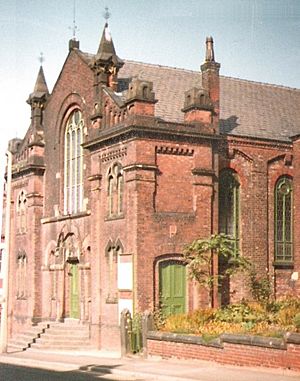
Westwood Moravian Church viewed from Middleton Road
|
|
| Religion | |
| Affiliation | Moravian Church |
| Year consecrated | 1869 |
| Location | |
| Location | Westwood Oldham Greater Manchester England |
| Architecture | |
| Architectural type | Church |
| Completed | 1869 |
| Direction of façade | South |
The Westwood Moravian Church started in 1865 in the Westwood area of Oldham, England. The Moravian Church is a Christian church with a long history. The first church building quickly became too small. So, a new, bigger church was opened in 1869. This church served the Moravian community until 2005. At that time, the church members moved to a new place in Royton. The original Westwood building is still standing today.
| Top - 0-9 A B C D E F G H I J K L M N O P Q R S T U V W X Y Z |
The Church Buildings
The Main Church Building
The first stone for the Westwood church was laid on August 5, 1865. This first building was on Main Road. It is now where the Sunday School stands. Soon, the chapel was not big enough for everyone. So, work began on a new church building in 1868. This new church was on Middleton Road. It opened on May 12, 1869. The Moravian Church used it until July 2005.
The outside of the 1869 church building was described in 2005. It had tall, pointed pillars around a main entrance. The door and windows had rounded tops. On each side, there were stairs leading up to the galleries inside.
A drawing from 1882 shows what the inside of the church looked like. The organ was at the north end. The pulpit, where the minister spoke, was in the middle. It had stairs on both sides. The communion table was in front of the pulpit. Rows of benches faced the table from different directions.
The inside of the church was changed a lot in 1924. New rooms were added for the Minister and choir. The front of the church got beautiful oak furniture. This included special seats for the choir. There was also a new communion table, chairs, and a screen to remember war heroes. A new pulpit was placed between the table and the Minister's room. These changes cost over £3,000.
In 1932, a special bowl for baptisms was given to the church. It was in memory of a church member named Br J J Lees. When the Westwood church closed in 2005, some of these items moved. The communion table, the memorial plaque, and a special symbol from the pulpit went to the new church in Royton. The baptismal bowl also moved there.
The Church Organ
In 1873, an organ was bought for the church. It cost £100. It was first played on Palm Sunday. In 1903, a new organ was installed. It was designed by George Benson from Manchester. This organ had different sets of keys and pedals. It was put in by Robert Jackson, who was an organist at another church in Oldham.
At first, water pressure powered the organ's bellows. The water then went to a nearby mill. In 1923, an electric blower was installed instead. In 1965, the Benson organ was thought to be worth £3,000. It was taken apart when the Westwood church building closed.
The Manse (Minister's House)
In August 1872, a house called the Manse was built next to the church. This was for the Minister and his family to live in. It was a large house with a big hall, staircase, and landing.
The Sunday School
After the 1869 church was built, the first chapel on Main Road became the Sunday School. In 1896, this school building was made longer. A three-story part was added. This work cost £650. The new building could hold 500 students.
However, on April 7, 1906, new foundation stones were laid for a brand new Sunday School Hall. This was on the same spot as the original chapel. Bishop C E Sutcliffe and others laid the stones. The architect was C T Taylor. This new building cost £1,850. It has a beautiful front on Main Road.
Church Life and Activities
The Moravian Community
Church Services and Sunday School
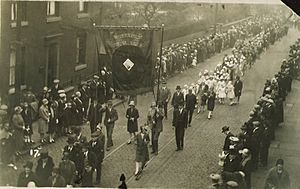
Westwood Moravian Church began in 1865. This followed some early work by Reverend Bennett Harvey and Reverend Frederic La Trobe. They had held meetings in homes the year before. The Westwood mission was in a new industrial area. It was set up by leaders from Salem Moravian Church in Oldham. They wanted to help their members who had moved to Westwood for work. Some members from Dukinfield Moravian Church also settled there.
The first public services were held in the new chapel on November 12, 1865. Forty adults came in the morning. Seventy came in the evening. At the first anniversary service, over 150 people attended in the morning. In the evening, the chapel was too full to hold everyone.
In 1900, the Sunday School had 31 leaders and teachers. There were 537 students. About 197 students came in the morning. About 377 came in the afternoon. In 1906, the church had 173 full members and 83 regular attendees. About 120 people came to morning services. About 200 came in the evening. About 90 attended Holy Communion.
In 1900, there were some complaints about the organist. People said his organ solos were too long. They also said he sometimes missed how many verses were in hymns. Sometimes the organist played alone. Other times, the church sang without music. Robert Jackson, who installed the 1903 organ, wrote a special tune. It was for the carol "While Shepherds Watched Their Flocks". This tune was very popular at Westwood. It was always the highlight of the Christingle Service before Christmas. The Christingle Service from Westwood was even broadcast by the BBC in December 1953.
Behind the church was the Oldham Corporation Tram Depot. In 1907, the church bought a piece of land from the Corporation. It was between the two buildings. The land was 196 square yards and cost £61.5.0. In 1910, the church thought about buying the Tram Depot too. But this never happened. In 1912, the church complained to the Tramways Manager. The noise of the trams often disturbed church services. The Manager was asked to tell drivers to go slowly past the church. They were also asked to stop ringing the bell at the end of the line during service times.
In 1958, the church had 94 full members and 15 regular attendees. There were also 183 children in the Sunday School. They had 32 teachers and leaders. In October 1965, Family Church was introduced. After this, about 170 people attended morning services.
Learning and Work
From the very beginning, the Minister at Westwood taught children. He taught reading, writing, and math in evening classes. Sunday School teachers also gave lessons in the mornings and afternoons. At that time, children could work up to twelve hours a day in mills and factories. They had short breaks for meals.
Public education was not provided in England until 1870. Even then, there were not enough school places. Many children could not be taught. In 1870, there were 18,085 school-aged children in Oldham. About half of them actually went to school. Just over 2,300 were taught in private schools. Records show that the Westwood Sunday School building was rented by day school teachers for private lessons. The School Hall was also used as an Employment Exchange. This was from 1922 to 1957.
Fun Social Activities
Westwood Moravian Church was a hub for the whole community. It was not just for church members.
In 1900, there were many groups linked to the church. These included the Band of Hope, the 7th Oldham Company of the Boys Brigade, the Women's Guild, and the Men's Institute. The Men's Institute even had two full-size billiard tables. The Boys Brigade closed in 1931. Its last leader was Br W Dunkerley.
A drama group started around 1897. It was restarted after the First World War. The Westwood Glee Club formed in 1931. In 1934, it joined with the drama group. This group was still very strong in the 1970s. They put on plays and comedies.
After much discussion, dancing was allowed from 1921. The Church and Sunday School committees decided together. No more than six dances were allowed in one night. Special nights like Christmas Eve and New Year's Eve were exceptions. So, dancing happened for the first time at the Christmas Eve Social that year. However, the Sunday School superintendent and another committee member resigned because they disagreed. The rules were relaxed in 1931. Dancing was then allowed for up to ninety minutes at any social event.
The Westwood Moravian Cricket Club started in 1883. It was still active in 1965. A recreation club for football, cricket, and tennis began in 1922. The Girl Guides started in 1932. Sr Emily Shaw was their leader. The Minister, Br Edward Barker, started the Boy Scouts during the Second World War. In 1953, a Wakes Club was set up. This continued an old tradition of saving money for holidays. Youth clubs had been at Westwood since at least 1943.
Important Church Meetings
In June 1939, the British Provincial Synod met in Oldham. This was a big meeting for the Moravian Church. The first session was held at Westwood on June 26. A session about missions on the afternoon of June 28 was also at Westwood. The ordination and communion services in the evenings were held there too.
Ministers from Westwood
Four men from Westwood became Ministers in the Moravian Church.
In 1904, Br Harry Lloyd was accepted for missionary training. He worked at Platt Brothers before this. He later sailed to the West Indies. He passed away in Antigua in 1941. His son, Ronald, was the Minister at Westwood from 1945 to 1954.
Br Handel Hassell trained to be a Moravian Minister. He studied at Fairfield College and the Victoria University of Manchester. He then worked at the Fulneck Moravian Settlement. When World War I started, he joined the British Army. He was very brave and won the Military Cross twice. After the war, he continued his ministry. He passed away in 1953 as the Principal of Fairfield College.
Br George Harp was ordained at Westwood on June 21, 1925. Bishop Arthur Ward led the service. Before his training, he worked at the Manor Mill in Chadderton. He studied theology at Bristol Mission College. He also had medical training at Livingstone College. In July 1925, he sailed to Labrador to work as a missionary.
In 1947, Br Fred Linyard entered Fairfield College. He earned degrees in arts and divinity from the Victoria University of Manchester. He then spent a year in the United States. He was ordained at Westwood by Bishop G W M MacLeavy in 1953. After serving in England and the West Indies, he became a member of the Provincial Board. When he retired, he became the editor of The Moravian Messenger. This is the national church magazine. He was also chosen for a special honorary position called Advocatus Fratrum in Anglia.
The Church Closes
The church building on Middleton Road and Neville Street was used until 2005. At that time, the church members moved. They first went to St Luke's Anglican Church in Chadderton. Then they moved to a smaller place in Royton, about six miles away. This move happened because the number of people living in Westwood changed. Also, it became harder to keep up the old church buildings.
Back in 1881, the Minister at Westwood, Br H Reichel, had suggested Royton. He thought it would be a good place to start a new church community.
List of Ministers
|
|
|
|
What Happened After the Moravians Left?
We do not know what the site was used for right after the Moravians left.
The church building is now used by Firwood Church. This is a free evangelical church.


